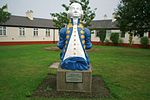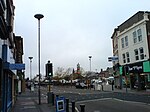River Blyth, Northumberland

The River Blyth flows eastwards through southern Northumberland into the North Sea at the town of Blyth. It flows through Plessey Woods Country Park. The River Pont is a tributary. The Blyth is 27 miles (44 km) long and the Pont is 17 miles (28 km).The tidal limit of the river is at Bebside. The estuary widens from this point eastwards and with the addition of a burn that enters on the northern side (Sleek Burn), it covers an area of 415 acres (168 hectares).Ecologists have suggested that a dam on the river at Humford Country Park in Bedlington could be removed to allow for fish migration. The local community have expressed a desire to keep the dam as it is a local beauty spot; they have suggested that a fish passage be built alongside instead.
Excerpt from the Wikipedia article River Blyth, Northumberland (License: CC BY-SA 3.0, Authors, Images).River Blyth, Northumberland
Beach Way,
Geographical coordinates (GPS) Address Nearby Places Show on map
Geographical coordinates (GPS)
| Latitude | Longitude |
|---|---|
| N 55.1165 ° | E -1.4891 ° |
Address
Outer West Pier
Beach Way
NE24 3PG , Crofton
England, United Kingdom
Open on Google Maps






